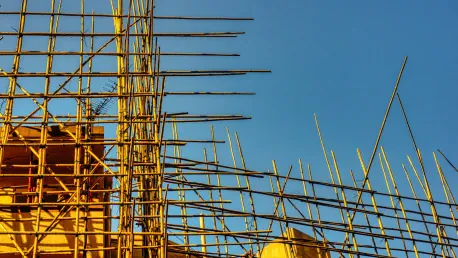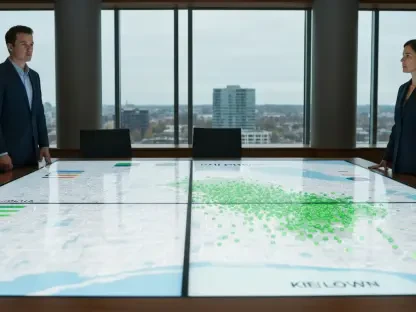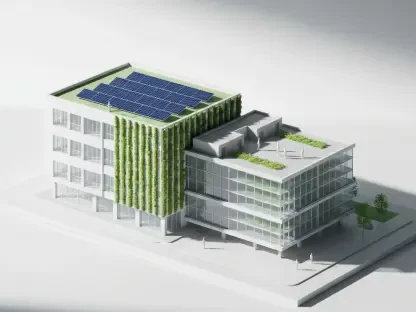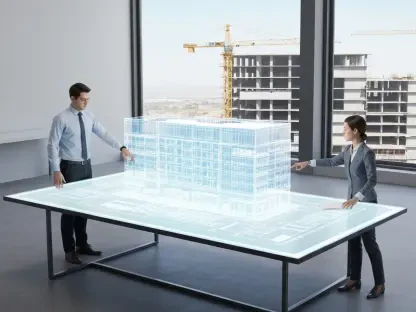The construction industry in the United States has always been highly sensitive to economic policies, and President Donald Trump’s erratic tariff strategies have added a new layer of unpredictability. Builders and contractors are now grappling with fluctuating costs and market instability, making future planning a formidable challenge. Initially, Trump’s broad-based tariff threats on U.S. imports created panic within the industry. The shock was momentarily softened when he announced a 90-day pause on tariffs aimed at reducing trade deficits. Despite this temporary reprieve, lingering concerns persist due to the ongoing implementation of significant tariffs, particularly a 145 percent tariff with China and a standard 10 percent rate on trade with most nations.
Impact on Lumber Prices
One of the most critical areas of concern is the effect of tariffs on Canadian softwood lumber. This material is indispensable in residential and commercial construction, making the current 14.5 percent tariff rate on Canadian lumber alarming to industry stakeholders. Expectations suggest that this figure could more than double to 34.5 percent, dramatically increasing the cost for about a quarter of the American lumber supply. These tariff hikes are projected to elevate construction costs in the short term. In contrast, long-term effects might be somewhat mitigated by increased domestic timber production. However, addressing this reliance on imports is not an immediate solution since planting new trees and expanding mill capacity are time-intensive processes.
The construction industry’s sensitivity to market disruptions makes the tariffs particularly harmful. Price volatility directly affects construction costs and industry profitability, especially for single-family and multifamily home builders dealing with the delicate nature of lumber prices. The National Association of Home Builders has acknowledged the complex issue of reciprocal tariffs but emphasized the inevitability of rising construction costs, a reality that destabilizes project plans and timelines.
Broader Economic Ripples
The tariffs’ impact isn’t confined to lumber alone. The broader economic ramifications are extensive, influencing prices across various materials and causing a ripple effect that impacts the entire construction sector. In places like Portland, where timber is extensively used in buildings up to 18 stories high, lumber price fluctuations could significantly alter development efforts focused on structures under three stories. The higher costs’ repercussions can stifle local development by rendering numerous projects financially unfeasible, given the razor-thin margins builders often operate on.
Federal contractors are uniquely disadvantaged due to contracts typically lacking escalation clauses that accommodate rising costs. Without these provisions, unexpected price hikes can erode profit margins in an industry already known for its low margins. Similarly, the private sector construction market, still recovering from the pandemic-related disruptions, finds itself battling additional obstacles as the trade war intensifies, further complicating an already difficult recovery trajectory.
Industry Uncertainty and Future Outlook
The consensus within the construction industry reflects anxiety and skepticism regarding Trump’s tariff strategies’ short-term consequences, particularly for countries reliant on trade, such as the United States. The inconsistent enforcement and frequent policy shifts are causing apprehension across the board, from high-rise developers to small-scale builders. The continual changes make it arduous for companies to develop long-term strategies or ensure project profitability, given the fragile nature of the market.
Addressing the root causes of this turbulence requires policy stability and predictability. While some industry experts suggest that increasing domestic production of key materials like lumber could offer partial relief, the time frame required for such measures to take effect means that the sector will continue to face challenges in the near term. Builders and contractors are left navigating a landscape fraught with uncertainties, always vigilant for further policy shifts that could affect their operations.
The situation underscores the broader economic ripple effects, bringing to light the necessity for a more stable and predictable policy environment to foster healthy industry growth during these volatile times. The construction industry’s need for stability and reduction in cost unpredictability is more pressing than ever, especially in light of enduring economic periods of volatility.
Conclusion and Future Considerations
The construction industry in the United States is extremely sensitive to economic policies, and President Donald Trump’s unpredictable tariff strategies have only added to the uncertainty. Builders and contractors are now struggling with fluctuating costs and market instability, which has made future planning even more challenging. Initially, Trump’s sweeping tariff threats on U.S. imports caused widespread panic in the industry. This shock was slightly mitigated when he announced a 90-day pause aimed at addressing trade deficits. However, this temporary relief didn’t fully eliminate ongoing worries. Significant tariffs remain, including a hefty 145 percent tariff with China and a general 10 percent tariff on trade with most other nations. The combined effects of these tariffs have introduced a level of unpredictability that makes it difficult for industry professionals to plan for the future. As a result, many are navigating a complex landscape of economic variables and market conditions, unsure of what moves to make next.









